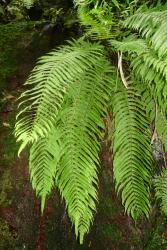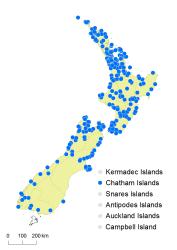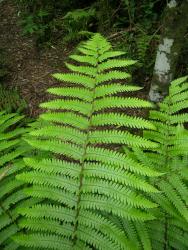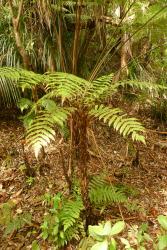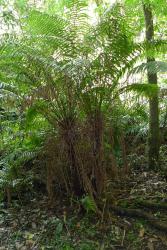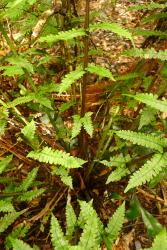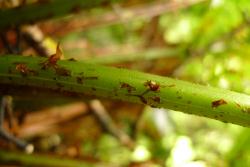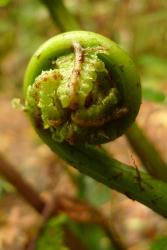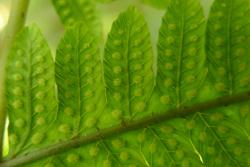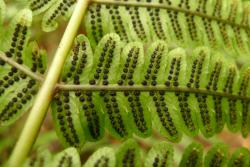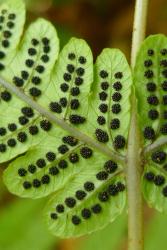- ≡ Polypodium pennigerum G.Forst., Fl. Ins. Austr. 82 (1786)
- ≡ Aspidium pennigerum (G.Forst.) Sw., J. Bot. (Schrader) 1800(2): 34 (1801)
- ≡ Nephrodium pennigerum (G.Forst.) C.Presl, Reliq. Haenk. 1, 35 (1825)
- ≡ Polystichum pennigerum (G.Forst.) Gaudich. in Freycinet, Voy. Uranie, Bot. 328 (1828)
- ≡ Lastrea pennigera (G.Forst.) C.Presl, Tent. Pterid. 76 (1836)
- ≡ Goniopteris pennigera (G.Forst.) J.Sm., J. Bot. (Hooker) 4: 54 (1841)
- ≡ Goniopteris forsteri T.Moore, Index Fil. 99 (1858) nom. illeg., nom. nov. pro Aspidium pennigerum (G.Forst.) Sw. 1801, nom. superfl.
- ≡ Dryopteris pennigera (G.Forst.) C.Chr., Index Filic. 283 (1905)
- ≡ Cyclosorus pennigerus (G.Forst.) Ching, Bull. Fan Mem. Inst. Biol. 10: 247 (1941)
- ≡ Thelypteris pennigera (G.Forst.) Allan, Fl. New Zealand 1, 51 (1961)
- ≡ Pneumatopteris pennigera (G.Forst.) Holttum, Blumea 21: 305 (1973)
- = Phegopteris cunninghamii Mett., Fil. Hort. Bot. Lips. 84 (1856)
- = Aspidium novae-zeelandiae Ettingsh., Denkschr. Kaiserl. Akad. Wiss., Wien. Math.-Naturwiss. Kl. 23: 103 (1864)
- = Polypodium pennigerum var. giganteum Colenso, Trans. & Proc. New Zealand Inst. 14: 339 (1882)
- = Polypodium pennigerum var. hamiltonii Colenso, Trans. & Proc. New Zealand Inst. 14: 338 (1882)
- ≡ Dryopteris pennigera var. hamiltonii (Colenso) Cheeseman, Man. New Zealand Fl., ed. 2, 36 (1925) – as hamiltoni
- ≡ Cyclosorus pennigerus var. hamiltonii (Colenso) Crookes in Dobbie, New Zealand Ferns ed. 4, 262 (1951) – as hamiltoni
- = Polypodium subsimilis Colenso, Trans. & Proc. New Zealand Inst. 20: 233 (1888)
Rhizomes prostrate or erect, often forming short arborescent trunks, rarely up to 1.89 m tall, bearing scales at the apex. Rhizome scales ovate to narrowly ovate, 3–8 mm long, 1–4 mm wide, chestnut-brown, entire. Fronds 340–2070 mm long, rarely only 200 mm long at high elevations, arching upwards. Stipes 40–430, rarely up to 770 mm long, pale brown, scaly to almost glabrous. Laminae 1-pinnate to 1-pinnate-pinnatifid, narrowly elliptic or elliptic, gradually tapering to a pinnatisect apex, 270–1390 mm, rarely up to 1500 mm long, 80–400 mm wide, rarely only 160 mm long and 50 mm wide at high elevations, mid-green on both surfaces, thin and herbaceous. Ovate or broadly ovate, pale brown scales on abaxial surface of costae; colourless or pale brown acicular hairs up to 0.2 mm long on both costa surfaces; colourless capitate hairs <0.1 mm long on abaxial surfaces of costae. Primary pinnae in 8–35 pairs below pinnatisect apex, widely spaced especially proximally, narrowly oblong to narrowly ovate; the longest at or near the middle, sessile or short-stalked, the longest 44–220 mm long, rarely only 27 mm long at high elevations, 11–34 mm wide; the basal pair greatly reduced, 10–70 mm long, auricled acroscopically. Primary pinnae divided ⅓ to ½, or rarely ⅔, to the midrib; ultimate segments (excluding proximal pair) 5–17 mm long, 3.5–7 mm wide, apices obtuse or rounded, margins entire or minutely serrate; the proximal pair of ultimate segments often longer than the others with the basal acroscopic segment occasionally greatly extended into a pinnatifid secondary pinna up to 53 mm long and 24 mm wide. Basal veins in adjacent pinna segments joining, unbranched in each ultimate pinna segment. Sori round, in one row either side of midrib away from pinna margins; indusia absent.
Pakau pennigera is recognised by its erect rhizome, primary pinnae divided ⅓ to ⅔ to the midrib with rounded segments, greatly shortened basal pinnae, veins in adjacent segments joining, indumentum on the abaxial surfaces comprising ovate scales and acicular and capitate hairs but lacking glands, and sori lacking indusia. The network of dark veins on the thin green fronds distinguishes P. pennigera from other common forest ferns.
North Island: Northland, Auckland, Volcanic Plateau, Gisborne, Taranaki, Southern North Island.
South Island. Western Nelson, Sounds-Nelson, Marlborough, Westland, Canterbury, Otago, Southland, Fiordland.
Three Kings Islands, Chatham Islands
Altitudinal range: 0–700 m.
Pakau pennigera occurs in lowland areas, extending locally to montane sites, throughout the North Island, growing from near sea level to about 700 m on Mt Maungatautari in the Waikato region. In the South Island it is largely confined to lowland areas in the northern half of the island, although it extends locally to Fiordland, Southland and the Otago Peninsula, and from near sea level to about 600 m on Banks Peninsula.
Also Australia (Queensland, Victoria, Tasmania).
A terrestrial fern that occurs under kauri, podocarp, broadleaved and beech forest, under mānuka, kānuka and Salix spp., and in Carex secta swamps. It grows on the forest floor, in gullies, on banks, streamsides and alluvial terraces, usually in heavy shade and damp sites, but sometimes in more open areas.
n = 72 (Brownlie 1954, as Cyclosorus pennigerus).
Kunze (1850) evidently believed that Cunningham’s (1837) concept of Aspidium pennigerum differed from that of Swartz (1801) and he created a nomen novum for it – Aspidium cunninghamii Kunze, Linnaea 23: 225 (1850). However, neither Kunze (1850), nor Cunningham (1837), provided a description and the name is therefore a nomen nudum. In any case, Kunze’s name is illegitimate, being a later homonym of Aspidium cunninghamii Colenso (1843).
A trunk of 1.89 m was recorded on a plant of Pakau pennigera in the Waitākere Ranges by Ford (2020 – as Pneumatopteris).



